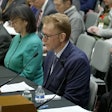Solo and small group radiology practices continue to defy the expectations of some observers by staying in business and focusing their practices differently than might be expected, according to the latest report from the American College of Radiology’s research department.
In an interview with AuntMinnie.com, the co-author of the report in this month’s American Journal of Roentgenology gave his take on "Basic Characteristics of Radiology Practices: Results from the American College of Radiology's 1999 Survey" (AJR, August 2003, Vol.181:1, pp. 341-349).
"My main impression ... is that change is really quite gradual," said Jonathan H. Sunshine, Ph.D., senior director for research for the Reston, VA-based ACR. "Certainly, the people who were predicting the imminent demise of solo practices and small practices were predicting a change a lot more rapid than has happened."
Although only 6% of the nation’s radiologists are in solo practice, according to the ACR’s sampling, they comprise nearly one-third of all American radiology practices. Solos and small groups with two to four radiologists represent nearly two-thirds of all practices.
But while the change may be gradual, the move toward larger practices is occurring. The 6% of radiologists in solo practice in 2000 was down from 8% in 1995; likewise, the 38% of radiologists practicing in groups of 15 or larger was up from just 30% in 1995, according to comparative data from the ACR research group published last year (AJR, February 2002, Vol.178:2, pp.291-301).
One finding in the latest report that surprised the researchers was that solo practitioners weren’t more limited to -- or pigeonholed in -- a particular type of practice.
"My thought, which may be mistaken, was that a lot of the solos were in non-metropolitan areas where they service very small rural hospitals and wouldn’t have established non-hospital practice sites," Sunshine said.
In fact, the ACR data shows that solo practitioners are on par with larger radiology groups in establishing non-hospital services. And they are less likely to serve only hospitals, suggesting a measure of flexibility that may bode well for the continuing viability of solo practices.
The researchers were also intrigued to find that radiology practices located in large metropolitan city centers were more much more likely to be owned by outside entities --regardless of whether it was an academic medical practice with university ownership, or another type of practice with outside investors.
This finding was surprising, Sunshine said, because "one tends to think of outside owners seeking suburban locations because the population is better insured."
By Tracie L. ThompsonAuntMinnie.com contributing writer
July 29, 2003
Related Reading
Indian Health Service career offers unique opportunities, July 17, 2003
Salary offers to radiologists jump 11%, July 14, 2003
Hunting for recruits, pediatric radiologists take aim at "misconceptions", June 26, 2003
CompHealth study finds radiologists attracted to locum tenens work, May 15, 2003
SalaryScan survey: Subspecialization pays off for radiology professionals, March 13, 2003
Copyright © 2003 AuntMinnie.com



















